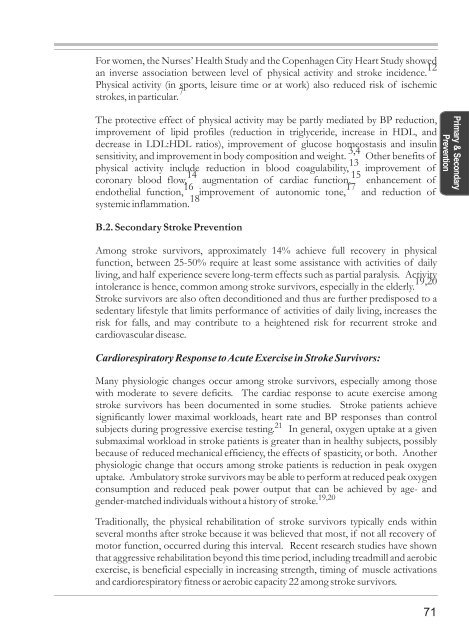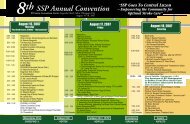Front Panel Painting “LIFE” By William T Chua MD
FREE download - Stroke Society of the Philippines
FREE download - Stroke Society of the Philippines
You also want an ePaper? Increase the reach of your titles
YUMPU automatically turns print PDFs into web optimized ePapers that Google loves.
For women, the Nurses’ Health Study and the Copenhagen City Heart Study showed<br />
an inverse association between level of physical activity and stroke incidence.<br />
12<br />
Physical activity (in sports, leisure time or at work) also reduced risk of ischemic<br />
strokes, in particular.<br />
7<br />
The protective effect of physical activity may be partly mediated by BP reduction,<br />
improvement of lipid profiles (reduction in triglyceride, increase in HDL, and<br />
decrease in LDL:HDL ratios), improvement of glucose homeostasis and insulin<br />
sensitivity, and improvement in body composition and weight.<br />
3,4<br />
Other benefits of<br />
physical activity include reduction in blood coagulability,<br />
13<br />
improvement of<br />
coronary blood flow,<br />
14<br />
augmentation of cardiac function,<br />
15<br />
enhancement of<br />
endothelial function,<br />
16<br />
improvement of autonomic tone,<br />
17<br />
and reduction of<br />
systemic inflammation.<br />
18<br />
B.2. Secondary Stroke Prevention<br />
Among stroke survivors, approximately 14% achieve full recovery in physical<br />
function, between 25-50% require at least some assistance with activities of daily<br />
living, and half experience severe long-term effects such as partial paralysis. Activity<br />
intolerance is hence, common among stroke survivors, especially in the elderly.<br />
19,20<br />
Stroke survivors are also often deconditioned and thus are further predisposed to a<br />
sedentary lifestyle that limits performance of activities of daily living, increases the<br />
risk for falls, and may contribute to a heightened risk for recurrent stroke and<br />
cardiovascular disease.<br />
Cardiorespiratory Response to Acute Exercise in Stroke Survivors:<br />
Many physiologic changes occur among stroke survivors, especially among those<br />
with moderate to severe deficits. The cardiac response to acute exercise among<br />
stroke survivors has been documented in some studies. Stroke patients achieve<br />
significantly lower maximal workloads, heart rate and BP responses than control<br />
subjects during progressive exercise testing. 21 In general, oxygen uptake at a given<br />
submaximal workload in stroke patients is greater than in healthy subjects, possibly<br />
because of reduced mechanical efficiency, the effects of spasticity, or both. Another<br />
physiologic change that occurs among stroke patients is reduction in peak oxygen<br />
uptake. Ambulatory stroke survivors may be able to perform at reduced peak oxygen<br />
consumption and reduced peak power output that can be achieved by age- and<br />
gender-matched individuals without a history of stroke. 19,20<br />
Traditionally, the physical rehabilitation of stroke survivors typically ends within<br />
several months after stroke because it was believed that most, if not all recovery of<br />
motor function, occurred during this interval. Recent research studies have shown<br />
that aggressive rehabilitation beyond this time period, including treadmill and aerobic<br />
exercise, is beneficial especially in increasing strength, timing of muscle activations<br />
and cardiorespiratory fitness or aerobic capacity 22 among stroke survivors.<br />
71<br />
Primary & Secondary<br />
Prevention



